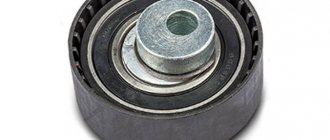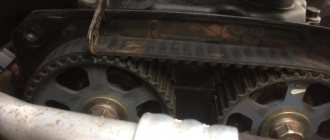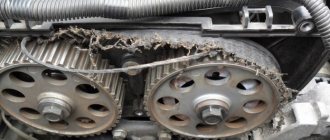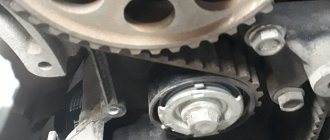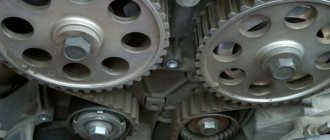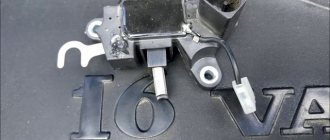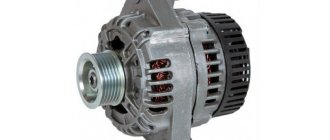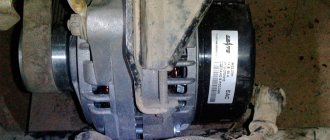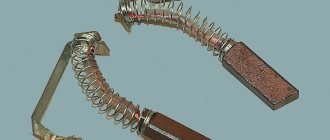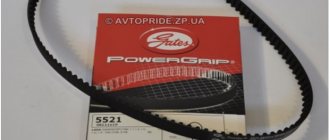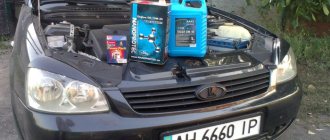According to the maintenance regulations for Lade Priore Timing belt replacement is provided during mileage every 200,000 km, and checking the condition of the belt and its tension must be done every 105,000 km. But, according to reviews from car owners, such a mileage is only possible on a belt installed from the factory.
After the first replacement of the timing belt and rollers VAZ 217030 (Lada Priora) 1.6 16 valves , it is necessary to reduce this regulation by 3 times . It is recommended to change the timing belt and rollers at a mileage of 50,000 km - 60,000 km , and inspect the belt every 25,000 km - 30,000 km .
If you detect even the slightest cracks on the belt or a hum in the roller bearings, it is necessary to urgently replace the rollers and toothed belt, since if the timing belt breaks, there are 16 valves on the 1.6 , the valves will bend and it will be necessary to repair the engine.
Why did it happen so?
Perhaps the automatic requests do not belong to you, but to another user accessing the network from the same IP address as you. You need to enter the characters into the form once, after which we will remember you and be able to distinguish you from other users exiting from this IP. In this case, the page with the captcha will not bother you for quite a long time.
You may have add-ons installed in your browser that can make automatic search requests. In this case, we recommend that you disable them.
It is also possible that your computer is infected with a virus program that is using it to collect information. Maybe you should check your system for viruses.
If you have any problems or would like our support team, please use the feedback form.
| The service life of the Priora/Kalina timing belt depends on the operating conditions and the quality of the product itself. The manufacturer recommends checking the belt at least once every 45,000 km. mileage If signs of wear appear, it is recommended to replace it with a new one. Do you know which timing belt is better to choose? |
The timing belt (Timing Belt) is a closed rubber belt with notches on the inside. It is designed to synchronize the engine crankshaft and camshaft.
What timing belt is installed on Priora and Kalina from the factory ? Standard timing belts for Niva Chevrolet and Lada Priora, Kalina from GATES (Gates). Belt part number: 21126-1006040 (5631XS).
The price of a timing belt starts from 1200 rubles. and depends greatly on regions.
How is a belt drive checked on a VAZ 2170?
The part is a rubber product with teeth located on its inner part. The outer rim shows:
- the type of motor for which the car part is intended;
- number indicating the number of teeth – 137;
- marking indicating the width of the product - 22 mm.
This data will be useful to the owner who does not yet know which belt to buy for the VAZ 2170. All that remains is to prepare the necessary tool for checking:
- inbus key (hexagon) to “5”;
- key to “10”;
- jack.
The drive status check is performed on a cold motor and consists of the following steps:
- Using a hexagon, unscrew the five bolts securing the front upper cover of the timing gear drive and remove it.
- Inspect the part and determine whether the Lada Priora needs to replace the timing belt . To do this, engage fifth gear, lift the right front wheel and rotate it clockwise. The product must be free of cracks, peelings and undercuts exposing the cord threads. If defects are found, the part must be replaced.
- Inspect the condition of the tension roller - there should be no damage to it.
- Check the belt tension by pressing a force of 10 kg on the belt between the camshaft gears and measuring its deflection - it should be no more than 5-7 mm . You can also carry out control by the position of mark 1 on the outer race of the self-tensioning roller, which ideally should be opposite the protrusion 2 . Deviations are permissible within 3-4 mm - they are adjustable, but exceeding these values means the need to replace the belt drive and rollers.
Alternator belt tension
For the standard alternator belt on a Priora, the size may vary depending on the configuration of various drive systems. The generator drive with hydraulic steering uses a generator belt with power steering with a poly-V-ribbed pattern, which has the nomenclature 6РК1115 and a length of 1115 mm. The Priora engine without hydraulics is equipped with a belt with the nomenclature number 6РК742, the circumference of which is 742 mm. When a vehicle is equipped with climate control equipment, a generator belt with an air conditioner with the nomenclature number 6РК1125 with a working surface length of 1125 mm is used as a drive mechanism.
Unscheduled tensioning of the generator belt on a Priora is required when this rubber product stretches due to wear during operation or when the adhesion of the belt surface to the plane of the generator belt tensioner roller, other rollers and pulleys decreases. In this case, it is necessary to tighten the generator belt to restore the normal functionality of the power plant.
Direct tensioning of the generator belt is carried out using a standard set of wrenches and a special wrench for the roller. If the alternator belt whistles in your car, you need to tighten it to avoid breaking. To do this, we carry out the following set of repair work:
- Slightly unscrew the fasteners of the generator belt tensioner roller, making sure to hold the clip with a wrench.
- Rotate the cage part of the eccentric roller to tighten the alternator belt, which improves its tension. Next, tighten the tension roller fasteners.
- When operating correctly, the belt deflection in a basic version car should not exceed 10 mm.
- In a modification equipped with an air conditioner or hydraulic steering mechanism, significant effort must be made to tighten the alternator belt.
Signs of tensioner failure
The following symptoms indicate poor adjustment or failure of the unit:
- whistling, increased noise, rustling from the generator unit (extraneous sounds are not necessarily associated with the tensioner, but may indicate its misadjustment or malfunction);
- hum and buzzing that occurs when the belt roller bearing of the Priora generator wears out;
- vibration of the roller and belt, indicating a worn bushing;
- too much belt deflection (more than 8 cm) or excessive tension (less than 0.6 cm) - if detected, adjustment must be made;
- the fastening bolt begins to heat up;
- backlash in the tension roller (this, like the hum, indicates a worn bearing);
- uneven wear and stretching of the belt on one side (as a rule, this sign indicates a bend in the tensioner bracket).
The purpose of the timing belt on a Priora 16 valves
This part of the timing composite structure performs the function of transmitting rotation to the camshafts from the crankshaft. And thereby ensures a synchronous cycle of the entire timing assembly. With the help of this part, the necessary delivery of fuel to the engine cylinders occurs at the right time. The belt additionally allows the water cooling pump to move.
The belt itself is made from high-quality, high-strength rubber. To avoid the possibility of rupture as much as possible and is shaped like a closed circle. The toothed structure of the belt creates good adhesion to the camshafts and does not allow movement along the marked marks. When a belt wears out, most often the teeth themselves are worn away on the inside, but the body of the belt remains intact.
The Priora is equipped with belts, the number of teeth of which reaches 137 pieces, the width of the belt is 22 mm. Despite the simplicity of the design of the belt, its importance in the proper operation of the entire vehicle is of great value.
We change the timing belt and rollers on a Lada Priora with a 1.6 liter 16 valve engine
Our neighbor came to us to undergo scheduled maintenance on his brand new VAZ 2170, or Lada Priora in common parlance, to replace the timing belt, pump, oil and other little things.
Different sources indicate different frequency of replacing the timing belt from 80 thousand km to 105 thousand, but we change it at 60 thousand or every four years. We check the belt tension and its condition every 20 thousand kilometers or once a year and this is not our whim, because we all know about the quality of our spare parts. When checking, we pay special attention to the absence of cracks and tears on the belt, as well as oil or antifreeze. And remember that saving on a timing belt can result in many times higher costs for engine repairs.
Important! When the timing belt on the 21126 engine breaks, all 16 valves bend.
And yet, not everyone knows, but on the sixteen-valve Priora engine, lightweight connecting rods are installed, and when the timing belt breaks, not only all 16 valves bend, but in most cases the connecting rods as well. And if they are not replaced, the car will have a decent oily appetite. Therefore, it is better to play it safe.
Together with the timing belt, we also change the pump, since in my experience most of the cases of toothed belt breakage occur due to a jammed pump.
How to change the generator roller on a Priora
The part cannot be repaired, only lubricated if its technical condition allows. If there is a malfunction, the spare part is replaced. Let's look at how to change the roller of a Priora generator with air conditioning.
To replace the Priora generator roller, you need a 17 mm wrench and a tension wrench.
Progress
There is almost nothing to disassemble:
- Unscrew the fixing bolt.
- Remove the old part (you should remove it carefully, making sure that the belt does not slip off, and holding it with your other hand).
- Install new one.
- Make sure that the belt fits into the grooves of all rollers and pulleys.
- Tighten the bolt, but do not tighten it completely.
- Adjust the tensioner.
- Tighten the bolt.
- Check tension.
Replacing rollers and timing belt: step-by-step steps
If you have an air conditioner, the replacement procedure will be more complicated. To replace the belt, first perform the following operations:
- Using a 15mm wrench, remove the generator tension roller and release the generator belt.
- Using the T-30 tool, you need to unscrew the bolts (5 pcs.) on the protective casing and 2 bolts on the lower casing.
- Raise the car with a jack to lift the wheel. This is necessary to connect the camshaft marks. We combine the marks on the body and the marks on the pulleys by turning the wheel in 5th gear.
the mark on the pin coincides vertically with the mark on the body
- When aligning the marks, the gear should be switched to neutral so as not to disturb the installed marks.
- Use a screwdriver to remove the flywheel plug. The flywheel mark should line up with the cut out triangle on the left.
- By turning the wheel all the way you gain access to the crankshaft.
- While the assistant holds the brake pedal depressed in 5th gear. You need to unscrew the crankshaft bolt counterclockwise and remove the washer.
- Using a 15mm wrench, unscrew the roller bolts, then remove the timing belt itself.
- To remove the pump (if there is an additional need for this), the closed casing and camshaft pulleys are removed.
- Then the generator roller mounts are removed, as well as 6 mounting bolts.
- After the procedure, it is necessary to install the mechanisms in the reverse order.
- The tensioner roller should not be secured; it will be needed for adjustment.
- We secure the camshaft and crankshaft pulleys.
- We first put the new belt on the crankshaft pulleys, then on the pump and camshaft.
After completing the installation of the belt, be sure to move on to the next stage - adjusting the timing belt.
Why does the alternator belt whistle on a warm Priora engine?
There may be several reasons why the VAZ-2110 alternator belt whistles. However, the first place in terms of frequency of occurrence is the wear and tear of the material from which it is made. The rubber stretches, loses its shape, and begins to slip.
Diagnostics is carried out visually, based on the degree of belt tension. If it sags and can be easily turned by hand (while the pulleys remain motionless), then the cause of the malfunction can be considered found.
Lada Priora generator installed on a car
The drive may not whistle constantly, but periodically whistle for some time after a cold start in winter. In general, if the situation returns to normal after warming up, no intervention is required. The fact is that the rubber from which the element is made becomes hard in the cold and does not adhere tightly to the surfaces of the pulleys. As it warms up, it takes on a working form and the whistling stops.
Replacing the timing belt. VAZ, Priora
It is recommended to install a new timing belt if even small defects are detected, since a broken belt greatly increases the time and financial costs of repairing an internal combustion engine. In order to replace the belt, you must have the following tool:
- key for rotating the roller (tensioner)
- a small pry bar or a large, durable screwdriver
Before you begin installing a new belt, you need to degrease all surfaces that come into contact with the belt. It is recommended to always replace the tension bearing together with the belt (as a rule, they can be purchased as a set).
Follow these steps:
Remove the negative cable from the battery by loosening the nut on the terminal. Remove the canister sensor and engine cover.
Unscrew the timing belt cover.
The two upper bolts are unscrewed with a TORX T30 wrench.
Using a 17 mm wrench, unscrew the tension roller bolt that tensions the drive belt.
Move the drive belt to the side.
Unscrew the 2 bolts of the lower part of the timing belt cover and remove it.
Using a 17 mm wrench, rotate the crankshaft and set the marks on the camshafts.
Correct tension of the Priora generator belt
The alternator belt whistles on a Priora! This problem or malfunction, so to speak, is felt by every tenth owner of this brand of AvtoVAZ’s brainchild! In today’s article I will tell you why the alternator belt whistles and how to get rid of the annoying noise.
The alternator belt is a structural element of the engine that transfers mechanical energy from the crankshaft to the generator, which, in turn, converts it into electricity. The interaction between the generator and the crankshaft is ensured by a belt connection mounted on pulleys.
